If you’ve ever seen a small lizard dash across your wall and then noticed a gecko, you might’ve thought they look almost the same. They both have four legs, scales, and quick, twitchy movements.
Sometimes people even call them by the wrong name without realizing it. But are lizards and geckos actually the same thing, or are they different?
Geckos are a type of lizard, but not all lizards are geckos. Geckos belong to a big group inside the lizard family, which means they share a lot of traits with other lizards but also have their own special features. Basically, every gecko is a lizard, but most lizards aren’t geckos.
Lizards come in thousands of species and they can be very different in size, how they act, and even how they see and communicate.
Geckos are just one branch of that big, scaly family, but they stand out for some very unique reasons.
Lizards and Geckos Are Family, but Not Twins
Think of lizards like one big extended family. Inside that family, you have smaller groups, or branches called families and genera. Geckos belong to one of those groups: the Gekkonidae family.
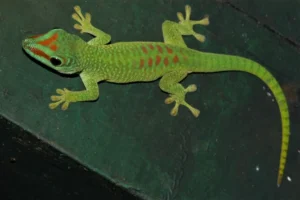
So, calling a gecko a lizard is like calling a husky a dog, or calling a raven a bird. It’s true, but there’s more detail behind it.
Lizards belong to a reptile group called Squamata, which also includes snakes. That’s why some lizards move in ways that remind you of snakes; they share a distant ancestor.
Geckos fit in that group, with over 1,500 species living in warm parts of the world.
They live in different environments, from deserts and rainforests to city walls and houses.
But even with all their differences, geckos still have the same basic lizard traits; scaly skin, a long tail, and the ability to move fast when scared.
What Makes Geckos Stand Out From Other Lizards
Even though they’re part of the lizard family, geckos are pretty easy to tell apart once you know what to look for.
One big difference is how they stick to walls. Most geckos have special toe pads covered with millions of tiny hair-like structures called setae.
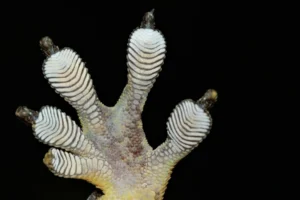
These make tiny contact with surfaces, letting them climb glass, ceilings, and walls easily. Try finding a regular lizard that can run upside down on a window. Almost none can.
Geckos also tend to be smaller, softer-skinned, and more colorful than many other lizards. Some species even have see-through skin where you can faintly see their insides.
Then there’s their voice. Unlike most lizards, geckos can make sounds. Some chirp, bark, or squeak to talk to each other, especially at night.
If you’ve ever heard faint clicking or chirping in a quiet room and found a small gecko nearby, that’s probably what you heard.
Regular Lizards Are a Lot More Different
If you look at other lizards, you’ll see a huge variety.
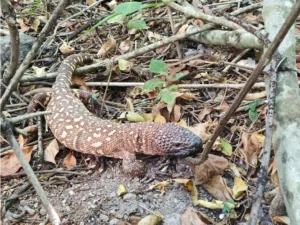
There are monitor lizards, which can grow several feet long, like the Komodo dragon (the largest living lizard in the world).
Then there are anoles, which are small and colorful. They can change color and have little throat fans called dewlaps.
Skinks are smooth and shiny, almost like snakes with legs. Many have tails that can break off to escape predators.
So while geckos are small, sticky, and often noisy, other lizards can be big, strong, or silent.
They all share the same reptile basics (cold-blooded bodies, scaly skin, and eggs with soft shells) but they’ve changed in many different ways.
So How Are Geckos and Other Lizards Related?
Scientists trace all modern lizards, including geckos, back to ancient reptiles that lived more than 200 million years ago.
Those early reptiles split into different lines, and one of those lines became Squamata; the group that later gave rise to lizards and snakes.
Within that group, geckos developed their own special traits over millions of years. Their sticky toe pads and night-time habits probably helped them survive in places where other lizards couldn’t.
That’s part of why geckos are found in so many parts of the world today; from Asian forests to African deserts to the walls of homes in tropical towns.
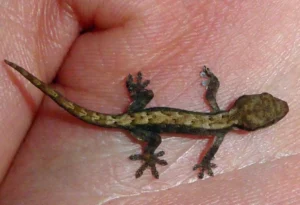
So while they share DNA with other lizards, they’ve gone their own way over time.
You could say geckos are the acrobats of the lizard family, with special skills for climbing and living at night.
Can You Tell Them Apart Just by Looking?
Usually, yes. Once you know the signs, it’s not too hard to spot a gecko versus another kind of lizard.
Here’s what to look for:
-
Skin texture: Geckos have softer, more velvety skin, while many lizards like skinks or anoles have shiny or rough scales.
-
Eyes: Geckos often have large eyes with vertical pupils and no eyelids. Instead, they lick their eyes clean with their tongues. Most other lizards have eyelids and blink.
-
Feet: Those famous sticky toe pads are a dead giveaway. If it can climb glass, it’s probably a gecko.
-
Sound: Geckos are talkative. Other lizards are almost always silent.
Once you notice those differences, you’ll start recognizing geckos instantly, even when they look a bit like small house lizards.
Why People Mix Them Up So Often
It’s easy to see why people confuse them. Both geckos and other small lizards often live around houses, especially in warm areas.
They both scurry up walls and disappear into cracks when you turn on the light.
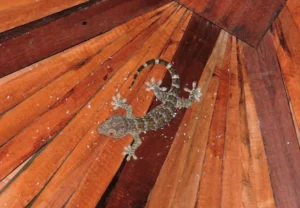
In many countries, people even call all small wall lizards “geckos,” whether they actually are or not.
For example, in tropical parts of Africa and Asia, house lizards are often called “geckos” because real geckos are so common indoors.
The confusion also comes from how much variety exists among lizards. A baby anole or skink might look nearly identical to a small gecko until you notice the eyes or skin.
So the mix-up isn’t surprising, it’s just one of those times where science is more specific than everyday language.
How Geckos Became the House Lizards We Know
If you live in a warm or humid place, chances are you’ve shared a room with a gecko at some point. They’re the little ones that show up near lamps at night, hunting moths or mosquitoes.
That’s not by accident. Over time, many geckos got used to living near humans because our houses attract insects and give them safe hiding spots.
Some species, like the common house gecko (Hemidactylus frenatus), have even spread worldwide by hitching rides on ships and cargo.

Meanwhile, most other lizards prefer outdoor areas (rocks, trees, or under logs) so you don’t see them in homes as often.
That’s another reason people think all house lizards are “geckos.”
Do Geckos and Other Lizards Get Along?
Not really. Lizards aren’t social animals, even with their own kind. They usually compete for space and food rather than hang out together.
A gecko might share a wall with another gecko if there’s plenty of food, but it’s not because they’re friends, it’s just tolerance.
If two different types of lizards meet, one usually runs away or hides to avoid trouble.
Each type has its own favorite temperature, humidity, and food, so they often stay in separate areas naturally.
Lizards Are a Huge, Diverse Group
To sum it up, “lizard” is a big word that includes thousands of species, everything from tiny geckos to giant Komodo dragons.
Geckos are just one small part of that family, but they’ve become some of the most familiar and well-loved lizards because they live so close to people.
So when you see a little creature running across your wall, it’s probably both: a gecko and a lizard. Just not all lizards are geckos.
Conclusion
So, are lizards and geckos the same thing? Not exactly. Geckos are part of the lizard family, but they’ve grown their own special traits that make them stand out.
They can climb smooth walls, make chirping sounds, and stay active at night, all things most lizards can’t do.
Next time you spot one on your wall, take a closer look. Notice its sticky toes, its big eyes, and the way it moves.
You’re looking at one of nature’s cleverest climbers.
Hi, my name is Ezra Mushala, i have been interested animals all my life. I am the main author and editor here at snakeinformer.com.

